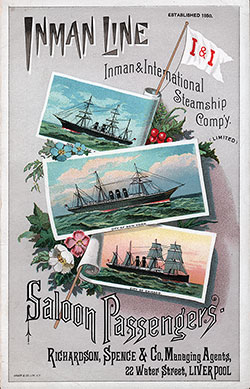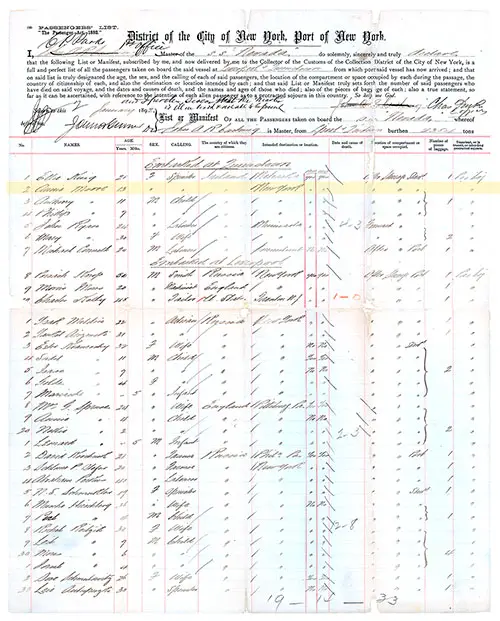Ellis Island Passenger Lists - 1892
Passenger lists for 1892 represent the souvenir list provided to the passengers of each cabin class (and other classes). Many of these souvenir passenger lists have disappeared over the years. Our collection primarily covers North American and European ports and ports in Australia and South Africa.
Our collection contains samples of passenger lists produced and printed by the steamship lines. These lists are often used to illustrate family history books for immigrants from this period.
Coveted by collectors and genealogists, souvenir passenger lists often offered beautiful graphical covers and information not found in official manifests because they focused on the journey rather than the destination.

1892-03-26 SS Spaarndam Passenger List
Steamship Line: Holland-America Line / Netherlands American Steam Navigation Company (NASM)
Class of Passengers: Cabin
Date of Departure: 26 March 1892
Route: Rotterdam to New York via Boulogne-sur-Mer
Commander: Captain Bonjer

1892-05-07 SS Friesland Passenger List
Steamship Line: Red Star Line
Class of Passengers: Cabin
Date of Departure: 7 May 1892
Route: Antwerp to New York
Commander: Captain Wm. G. Randle

1892-06-04 SS City of Chester Passenger List
Steamship Line: Inman Line
Class of Passengers: Saloon
Date of Departure: 4 June 1892
Route: Liverpool to New York
Commander: Captain F. M. Passow

1892-09-03 SS Maasdam Passenger List
Steamship Line: Holland-America Line / Netherlands American Steam Navigation Company (NASM)
Class of Passengers: First and Second Cabin
Date of Departure: 3 September 1892
Route: Rotterdam to New York via Boulogne-sur-Mer
Commander: Captain Aldert Potjer

1892-09-13 SS Havel Passenger List
Steamship Line: North German Lloyd / Norddeutscher Lloyd
Class of Passengers: Cabin
Date of Departure: 13 September 1892
Route: Bremen to New York
Commander: Captain Th, Jüngst

1892-11-19 SS La Gascogne Passenger List
Steamship Line: Compagnie Générale Transatlantique / French Line (CGT)
Class of Passengers: Cabin
Date of Departure: 19 November 1892
Route: Le Havre to New York
Commander: Captain S. Santelli
Please help us make our passenger list collection more complete. We would appreciate a digital copy if you have an 1892 souvenir passenger list. Please email us at history@ggarchives.com.
Recap and Summary of the Ellis Island Passenger Lists - 1892 Index Page
The Ellis Island Passenger Lists for 1892 mark the beginning of a new era in U.S. immigration history, as Ellis Island officially opened on January 1, 1892, replacing the Barge Office as the main immigration processing station in New York. These souvenir passenger lists, issued by steamship companies rather than immigration authorities, provide a detailed look at transatlantic travel, particularly for cabin and saloon-class passengers.
This collection features ships from Holland-America Line, Red Star Line, Inman Line, North German Lloyd, and the French Line (CGT)—all major carriers of European emigrants and business travelers. The voyages documented here primarily connect New York with Rotterdam, Antwerp, Liverpool, Bremen, and Le Havre, reflecting key European emigration hubs of the time.
Notable Highlights from 1892 Passenger Lists
- SS Spaarndam (Holland-America Line) – 26 March 1892
- Route: Rotterdam to New York via Boulogne-sur-Mer
- Passenger Class: Cabin
- Commander: Captain Bonjer
- Significance: The Holland-America Line played a crucial role in transporting Dutch, German, and Eastern European emigrants to the U.S. The Rotterdam–New York route was one of the most important paths for Dutch and Central European migration. The stop in Boulogne-sur-Mer, France, allowed additional passengers from the continent to board before crossing the Atlantic.
- SS Friesland (Red Star Line) – 7 May 1892
- Route: Antwerp to New York
- Passenger Class: Cabin
- Commander: Captain Wm. G. Randle
- Significance: The Red Star Line was one of the primary transporters of Belgian and Eastern European emigrants. Many Jewish emigrants escaping persecution in Russia and Poland traveled via Antwerp to the U.S. aboard Red Star Line vessels. The Friesland’s focus on cabin passengers suggests that this voyage included middle-class emigrants or business travelers rather than the large steerage crowds typically associated with Red Star ships.
- SS City of Chester (Inman Line) – 4 June 1892
- Route: Liverpool to New York
- Passenger Class: Saloon
- Commander: Captain F. M. Passow
- Significance: The Inman Line was one of the earliest steamship companies to emphasize comfort for saloon-class travelers, making it a popular choice for wealthier passengers and professionals. Liverpool was one of the busiest departure points for both emigrants and business travelers.
- SS Maasdam (Holland-America Line) – 3 September 1892
- Route: Rotterdam to New York via Boulogne-sur-Mer
- Passenger Class: First and Second Cabin
- Commander: Captain Aldert Potjer
- Significance: The Holland-America Line provided a more structured migration experience, appealing to both upper-class and middle-class travelers. The inclusion of both first and second-class passengers suggests that some emigrants were traveling with better financial resources, possibly including professionals or artisans relocating to America.
- SS Havel (North German Lloyd) – 13 September 1892
- Route: Bremen to New York
- Passenger Class: Cabin
- Commander: Captain Th. Jüngst
- Significance: Bremen was a major departure point for German and Eastern European emigrants. The North German Lloyd line was one of the largest carriers of emigrants, often offering both steerage and cabin accommodations. This voyage highlights the presence of middle-class German travelers and professionals who could afford cabin-class accommodations.
- SS La Gascogne (French Line - CGT) – 19 November 1892
- Route: Le Havre to New York
- Passenger Class: Cabin
- Commander: Captain S. Santelli
- Significance: The French Line (CGT) served diplomats, businessmen, and well-off emigrants traveling between France and America. The regular presence of CGT vessels in this collection demonstrates the strong economic and cultural ties between France and the U.S.
Historical Context – Events Impacting Ocean Travel in 1892
1. Opening of Ellis Island (January 1, 1892)
- The Ellis Island Immigration Station officially opened on January 1, 1892, replacing the Barge Office as the primary entry point for millions of immigrants.
- The first immigrant processed at Ellis Island was Annie Moore, a 15-year-old Irish girl, symbolizing the massive migration from Europe.
- This shift streamlined immigration processing with better facilities and medical inspections, but it also marked the beginning of stricter immigration enforcement.
2. Increased Immigration from Central and Eastern Europe
- Immigration from Germany, Russia, Poland, and Italy continued to rise, with many Jewish, Catholic, and Eastern Orthodox emigrants escaping persecution and poverty.
- Ships like the SS Spaarndam, SS Friesland, and SS Havel carried thousands of emigrants, particularly from Eastern Europe, to Ellis Island.
3. Expansion of Holland-America and Red Star Line Services
- The Holland-America Line and Red Star Line expanded their services to accommodate the growing number of emigrants from Belgium, the Netherlands, and Germany.
- The Holland-America Line’s structured migration system helped many Dutch and Central European emigrants settle in the U.S..
4. Continued Growth of Luxury Transatlantic Travel
- The Cunard, Inman, and French Lines continued to upgrade accommodations for saloon and cabin-class passengers, attracting business travelers, diplomats, and wealthy emigrants.
- The SS City of Chester and SS La Gascogne reflect the emphasis on high-class service for transatlantic travelers.
5. The U.S. Tightens Immigration Laws
- The U.S. Congress passed the Geary Act in 1892, extending the Chinese Exclusion Act and placing further restrictions on non-European immigrants.
- While European immigrants were arriving in record numbers, the U.S. government began discussing ways to further regulate and control immigration, which would continue into the 20th century.
Final Thoughts
The Ellis Island Passenger Lists for 1892 document a historic moment in U.S. immigration history, as Ellis Island became the primary processing center for new arrivals. This collection captures the diversity of transatlantic passengers, from wealthy saloon-class travelers to middle-class emigrants who could afford cabin accommodations.
Key takeaways from this collection include:
- The opening of Ellis Island and its impact on immigration processing.
- The rising number of Central and Eastern European emigrants.
- The increasing role of Holland-America and Red Star Line in transporting emigrants.
- The expansion of luxury transatlantic travel for business professionals and wealthy passengers.
This collection serves as a valuable historical resource, offering insight into the evolution of ocean liner travel, the transformation of U.S. immigration policies, and the early days of Ellis Island as a gateway to America.
Annie Moore, The First Immigrant Through Ellis Island
Anna Moore, Age 13, Is Recognized As the First Immigrant to Pass Through Ellis Island. She Is the Second Name Listed on the Passenger Manifest for the District and City of New York, Port of New York, for the Ss Nevada. the Ship Sailed From Liverpool and Queenstown, Arriving at Ellis Island on January 2, 1892. Note: Yellow Highlight Added for Emphasis. GGA Image ID # 21f3a31c6e. Click to View a Larger Image.
Anna "Annie" Moore (April 24, 1874 – December 6, 1924) was an Irish émigré who was the first immigrant to the United States to pass through federal immigration inspection at the New York Harbor Ellis Island station. Bronze statues of Moore, created by Irish sculptor Jeanne Rynhart, are located at Cobh in Ireland and Ellis Island.
Moore's arrival at Ellis Island from County Cork, Ireland, aboard the Guion Line steamship Nevada on January 1, 1892, was a significant moment in history. As the first person to pass inspection at the newly opened facility, she was presented with an American $10 gold piece from an American official, marking the beginning of a new era in immigration.
Moore's parents, Matthew and Julia, came to the United States in 1888 and lived at 32 Monroe Street in Manhattan. Annie married a son of German Catholic immigrants, Joseph Augustus Schayer (1876–1960), a salesman at Manhattan's Fulton Fish Market, with whom she had about eleven children. She died of heart failure on December 6, 1924, at age 50 and is buried in Calvary Cemetery, Queens. Her previously unmarked grave was identified in August 2006, a testament to the respect and recognition of her significant role in American history.
After visiting Ellis Island, Annie Moore's life, filled with courage and resilience, inspired the song "Isle of Hope, Isle of Tears" by Brendan Graham, a testament to the emotional impact of her journey and the inspiration she continues to provide.
Learn more about why Ellis Island was called the Isle of Hope, Isle of Tears.

